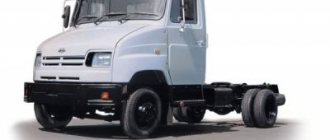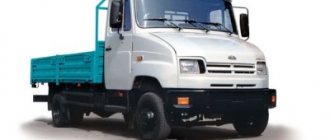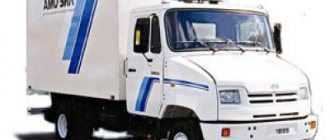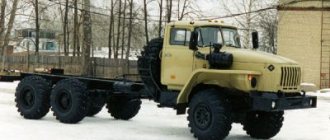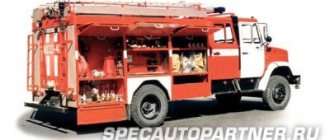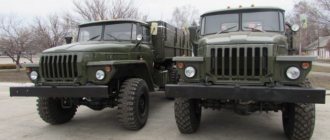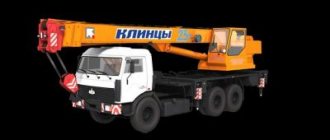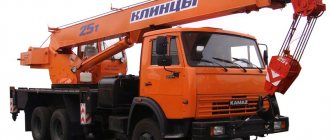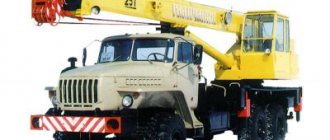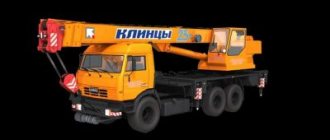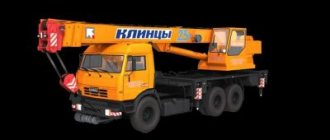- home
- Media center
- Articles
- How much oil is in the ZIL Bychok engine
Menu
- News
- Articles
- Video materials
- Photo materials
- Publication in the media
- 3D tour
26.02.2021
The bull ZIL belongs to the category of light-duty cargo vehicles. It has a number of undeniable advantages, therefore it has been modernized many times and is still used for various purposes. The use of transport leads owners to frequent questions, one of the most popular being the need for accurate information about how much oil to pour into the Bychka ZIL tank. Let's explore the topic in more detail.
Oil for gura zil byk
ZIL-5301 Bull.
STEERING The vehicle is equipped with hydraulic power steering, combined into one unit with a steering mechanism that incorporates a hydraulic safety valve.
Every day before starting work, you need to check the angular free play of the steering wheel when the engine is running at idle, shaking the steering wheel until the steering wheels begin to turn. The angular free play of the steering wheel when the engine is running should not exceed 25°. Free play should be checked by first setting the front wheels straight. If the free play of the steering wheel is more than permissible, you need to check the condition of the steering rods and their hinges, the adjustment of the steering mechanism, the clearances in the propeller shaft joints, the tightening of the propeller shaft mounting wedges, and the tightening of the thrust bearing nuts in the steering mechanism. If the steering mechanism or rods are not adjusted correctly, the unit must be repaired.
If there are increased gaps in the cardan joints, the cardan shaft must be replaced or repaired. After making sure that the listed components are in satisfactory condition, you should check the tightness of the steering gear thrust bearing nuts.
Axial movement of the steering wheel is not permitted. If there is axial movement of the steering wheel, it is necessary to tighten the column bearing fastening nut screwed onto the lower end of the shaft, having first straightened the antennae of the lock washer. After adjustment, bend one of the antennae
into the groove of the nut. The rotation torque of the steering shaft, disconnected from the propeller shaft, should be equal to 0.3. 0.8 N.m.
Excessive tightening of the nut and then unscrewing it to obtain the specified shaft torque is unacceptable, as it may cause damage to the bearing.
To check the steering mechanism, you need to disconnect the steering rod and measure the force in three positions with a spring dynamometer attached to the steering wheel rim.
If the forces do not correspond to those specified, then you need to adjust the steering mechanism in a specialized workshop.
When operating the vehicle, it is necessary to regularly check the oil level in the pump reservoir within the time limits specified in the lubrication chart. When checking the oil level, the vehicle's front wheels must be straight. Before unscrewing the wing nut and removing the cap from the tank, you must thoroughly clean it of dirt.
For a power steering system, use only clean, filtered oil specified in the lubrication chart. A paper filter is installed in the pump reservoir, which must be changed every 40 thousand km. In this case, add oil to the top mark on the tank. The oil level is considered normal if it is between the marks stamped on the wall of the tank.
When changing the oil, you need to do the following: disconnect the longitudinal steering rod; turn the steering wheel to the left until it stops; remove the tank cap by unscrewing the wing nut; open the drain hole by unscrewing the plug with the magnet from the steering gear housing.
Drain the oil until oil stops flowing from the drain hole;
remove the remaining oil and paper filter from the pump reservoir;
pour 1 liter of fresh oil into the tank through a funnel with a double mesh and drain it through the drain hole, turning the steering wheel from lock to lock;
screw the plug with the magnet into the drain hole of the steering gear housing;
install a new element and secure it with a clamping bar (Fig. 26);
with the steering wheel turned all the way to the left, pour fresh oil into the pump reservoir up to the marks and, rotating the steering wheel from lock to lock, add oil until at least 2.5 liters are filled into the system;
Start the engine and, while idling, rotate the steering wheel from lock to lock, holding it briefly in extreme positions for 2.3 s with a force of approximately 100 N, and add oil to the top mark as necessary. Filling the oil and removing air from the system is considered complete when the release of air in the form of bubbles through the oil in the pump reservoir stops;
stop the engine and remove the clamping bar from the paper filter;
install the reservoir cap with a spring and sealing gasket, a rubber ring, a washer and tighten the cap with a wing nut. The wing nut should only be tightened by hand. If oil leaks from under the reservoir cap, check that the cap gasket is installed correctly and, if damaged, replace it;
attach the longitudinal steering rod. The steering drive consists of longitudinal and transverse steering rods. The steering rod ball garnishes are adjustable and covered with rubber covers. Operating a vehicle with torn covers is not permitted.
When adjusting the hinge, the plug must be tightened until it stops, and then released to the first possible position for the cotter pin (but not less than 1/8 of a turn) and secured with a cotter pin.
To lubricate the hinge, you need to unscrew the plug from the end of the rod, screw in the oiler in its place and lubricate the hinge until fresh grease is squeezed out from under the cover. If, during the process of replenishing lubricant, the boot does not allow it to pass through, then to prevent damage to the boot, lubrication should be stopped after filling the cavity of the boot with lubricant,
which is determined by the increase in elasticity of the latter. After lubrication, you need to install the plugs in place.
It should be remembered that complete elimination of hinge clearances is not allowed, as this can lead to breakage of the ball pin or rod. The moment of swing and rotation of the ball pin should be no more than 50.0 N.m.
The cross rod has right and left threads at the ends for screwing on heads with ball joints. Using the heads, you can change the length of the rod and, therefore, adjust the toe-in of the front wheels.
Source
Engine Description
The truck in question was equipped with several types of engines at different times:
- MMZ D-245.12S (Euro 0);
- MMZ D-245.9 E0 (Euro 0);
- MMZ D-245.9 E2 (Euro 2);
- MMZ D-245.9 E3 (Euro 3).
From April 2008 to the present day, all ZIL-5301 models are equipped with engines that meet Euro 3 requirements in terms of their environmental qualities.
After reading this article, you will be convinced that buying a used Hovo dump truck in many cases is much more profitable than purchasing a new one.
The MMZ D-245.9 engine has the following characteristics:
- type – diesel, four-stroke;
- cooling – liquid (antifreeze);
- formation of the fuel mixture - direct injection;
- total number of cylinders – 4 pcs.;
- cylinder diameter – 110 mm;
- piston stroke length – 125 mm;
- total combustion chamber volume – 4.75 l;
- compression (calculated value) – 15.1;
- the maximum possible power at rated speed is 136 hp. With. (100 kW);
- crankshaft rotation speed – 2,400 rpm;
- fuel consumption – 215 g/kW;
- torque (maximum) – 460 N×m;
- weight – 430 kg (dry), 500 kg (with filling fluids).
The engine in question, among other things, is equipped with a turbocharger - this is one of the reasons for such high power. The design involves cooling the air before blowing (intermediate).
The overall dimensions of the motor are relatively small, despite years of development:
- length – 1,016 mm;
- height – 1,035 mm;
- width – 719 mm.
Consumption is approximately 12 liters for every 100 km at a speed of no more than 60 km/h.
“Bychok” is quite fast and can compete even with its foreign counterparts: the maximum speed with maximum load, according to the accompanying documentation, is 95 km/h.
Color classification
It is wrong to be guided only by color gradation when choosing oil, although this practice is widespread among car owners. It is also often indicated what color liquids can be mixed and which ones should not be mixed.
Mixing is contraindicated with liquids based on composition and not color, and since now both mineral water and synthetics can be presented in any color, you should treat this information very carefully.
Red ATF gear oil is usually synthetic, the Dexron brand from General Motors is considered the standard, but there are products from other manufacturers, such as Revenol, Motul, Shell, Zic, etc.
Yellow oil, produced by the Daimler concern and under its license, is used in Mercedes-Benz hydraulic boosters. It can be synthetic and mineral.
Brake system
The car in question is equipped with a dual-circuit braking system. Each circuit is completely independent. One of them brakes the front right and rear left wheels.
The second is front left and rear right. Thus, maximum safety on the road is achieved: even if one of the system components fails, emergency braking remains quite possible.
The brakes are operated hydraulically. Air amplifier (pneumatic). There is also a handbrake; it is mechanically connected (with a steel cable) to the rear mechanisms. The brakes have the following design:
- front – disc type;
- rear - drum.
The latest models, released recently, are equipped with an anti-lock braking system (ABS).
One of the models of a light-duty truck from the Mercedes Benz concern called Vario was used as a prototype of the car.
The design of the frame was inherited from him - a ladder type, in which there are spars with a “channel” type section.
Such design features allow the Bull to be quite safe, since even in a head-on collision at high speed, the likelihood of the frame structure folding is minimal. The frame has the following overall dimensions:
- width – 845 mm;
- spar flanges (width) – 70 mm;
- The thickness of the metal from which the spar is made is 5 mm.
Liquid composition
Based on the composition of the power steering fluid, it can be divided into mineral, semi-synthetic and synthetic. The chemical composition determines the basic set of oil functions:
Synthetics and mineral water cannot be mixed with each other, since the types of additives in them have fundamental differences.
Synthetics
These are high-tech liquids, in the production of which the most modern developments and additives are used. Oil fractions for synthetics are purified by hydrocracking. Polyesters, polyhydric alcohols and sets of additives give them outstanding characteristics: a wide range of operating temperatures, stable oil film, long service life.
The main reason why synthetic-based hydraulic fluid cannot be poured into power steering intended for mineral ones is its aggressive effect on rubber products, of which there are many in the hydraulic booster. Where synthetics are used, the rubber has a completely different composition and is made on a silicone basis.
Semi-synthetics
A mixture of synthetic and mineral oils, due to which the latter receive significant improvements in performance: reduced foaming, fluidity, heat dissipation.
Semi-synthetic fluids include such well-known fluids as: Zic ATF Dex 3, Comma PSF MVCHF, Motul Dexron III and others.
Mineralka
Mineral-based oils contain petroleum fractions (85-98%), the rest are additives that improve the performance of the hydraulic fluid.
They are used in hydraulic boosters containing seals and parts based on ordinary rubber, since the mineral component is neutral and is not harmful to rubber products, unlike synthetics.
Mineral power steering fluids are the most inexpensive, but they also have a short service life. Mobil ATF 320 Premium is considered a good mineral oil; Dexron oils up to and including the IID marking were also mineral.
Device
Over the course of 10 years, the company has created more than 35 models based on Bychok, which differ in design and technical characteristics. The main ones are as follows:
- ZIL-5301AO is an onboard classic model for transporting cargo on hard road surfaces.
- ZIL-5301BO is a cargo chassis for installing specialized superstructures, such as cash-in-transit, postal, fire equipment, and dump trucks.
- ZIL-5301GO is an isothermal van based on ZIL-5301BO.
- ZIL-5301 EO - extended chassis for additional special equipment.
- ZIL-5301TO is a vehicle with sides and a long frame, having a 2-row, 4-door cabin, used for repair and technical purposes.
- ZIL-5301YUO - a vehicle chassis with an extended base, equipped with a 2-seater cabin and 2 berths, used for retrofitting with special bodies and superstructures.
- ZIL 5301VA is a model with a thermal body, equipped with an extended 2-seater cabin and 2 seats for rest, used for transporting goods on general roads.
- ZIL-5301VE - flatbed truck.
- ZIL-540100 Bychok is a truck tractor for transporting materials and cargo as part of a road train on all types of roads.
- ZIL-432720 is a flatbed truck with a 4x4 wheel arrangement.
To create buses according to the 4x2 scheme, they use the chassis of ZIL-5301 vehicles with different wheel bases. The company also produces cargo-passenger vehicles based on the Bychka with special configurations, for example:
- Lux series bus with washbasin, dry closet, ventilation system, high quality interior lining, equipped seats;
- ritual hearses ZIL-325010-40 and ZIL-32500-40;
- car van ZIL-5301SS without a heater in the cabin and an ABC brake mechanism for transporting dry goods;
- The KO-503V sewer truck on the ZIL-5301 chassis is a tank truck with a hydraulic pump for cleaning ditches, wells and sewer pits with further removal to disposal sites.
Electrical equipment
The electrical equipment system in the cars is 1-wire. The negative terminals of the current sources are connected to the truck body. The on-board network uses low-voltage electrical wiring of the PGVA type of different colors and cross-sections. Rated voltage - 12 V, trigger voltage - 24 V. The types of main electrical devices are given in the explanations for the ZIL-5301 electrical diagram.
The main mechanisms in the electrics of the machine, according to the detailed color wiring diagram, are:
- batteries;
- generator;
- voltage regulator;
- transformer-rectifier unit (TVB);
- starter;
- lighting;
- light alarm;
- safety mechanisms and relays;
- windshield wipers and washers;
- sound alarm;
- heater
The trucks are equipped with alternating current generators with built-in rectifiers and a capacitor.
TVB is a 3-phase transformer, the windings of which are connected in a triangle. It has 2 terminals for connecting to an additional battery and a connecting block with 3 plugs for connecting to the terminals of the generator phases.
The voltage regulator contains 2 isolated terminals “Ш” and “+”, maintains the generator voltage and works with an electrolyte temperature sensor.
The fuses are located to the right of the driver behind the instrument panel. They turn off the wiring when the current limit is exceeded. The markings on the harnesses show what current is suitable for each fuse if they blow.
Lighting and light signaling according to the ZIL “Bychok” electrical circuit include:
- front and side turn signals;
- rear lights;
- lighting lights for the car number;
- interior lights;
- headlights.
The sound signal is installed below the cabin mudguard on the left side of the machine.
The electrics of the heating system include:
- electric motors with permanent magnets of series excitation;
- electronic control unit;
- switch.
The electrical circuit of the heater is protected by a bimetallic fuse.
Brake system
The ZIL-5301 brake system is represented by a combined pneumohydraulic drive with 2 independent hydraulic and pneumatic circuits, which are divided into 2 branches. The Bychok model buses have an ABC system.
The front wheel brakes are disc brakes with floating 2-cylinder calipers, 2-pad. The rear wheel brakes are equipped with drum-type pads.
The parking brake drive is mechanical from a spring energy accumulator with pneumatic control.
Transmission
All modifications of the car are equipped with a mechanical 3-way 5-speed gearbox with synchronizers, facilitating control, ensuring noiseless gear shifting and increasing the operating life of gear couplings. A swinging transmission switch lever with a ZIL gear shift diagram is mounted on the box cover: 5 speeds for forward movement and 1 speed in reverse.
Different types of oils
Dexron is a separate class of ATF fluids from General Motors, produced since 1968. Dexron is a trademark, produced both by GM itself and by other companies under license.
ATF (Automatic Transmission Fluid) - oils for automatic transmissions, often used by Japanese automakers and in power steering.
PSF (Power Steering Fluid) - literally translated as power steering fluid.
» alt=»»> Multi HF - special, universal power steering fluids that have approvals from most automobile manufacturers. For example, CHF liquid, produced by the German company Pentosin, has received approvals from BMW, Ford, Chrysler, GM, Porsche, Saab and Volvo, Dodge, Chrysler.
Let's sum it up
The car had many advantages, which is why it was in great demand both from private carriers and from large companies. Over time, it was modernized, it became more environmentally friendly and easier to operate. If you compare the latest and first models, you can notice a significant difference in the quality of assembly and the operation of machine elements.
Considering the car’s considerable journey through changes and assembly line production, we can expect that in the future the model may acquire new data that will once again make the good old “Bull” one of the most popular light-duty vehicles.
We advise you to read the article: ZIL - the history of the auto giant
In the 90s, a light-duty truck produced by the Likhachev Automobile Plant was quite popular.
It had many advantages, which is why it was in great demand both from private carriers and from large companies. Over time, it was modernized, it became more environmentally friendly and easier to operate.
Is it possible to fill the power steering with engine oil?
Motor - definitely not, transmission - with reservations. Next we will look in detail why.
To understand whether other oils, such as motor or transmission oils, can be poured into the power steering, you need to know what functions it performs.
The power steering fluid must cope with the following tasks:
The above characteristics are achieved by adding various additives, the presence and combination of which gives power steering oil the necessary qualities.
As you understand, the tasks of motor oil are somewhat different, so it is highly not recommended to pour it into the power steering.
Regarding transmission oil, everything is not so clear; the Japanese often use the same ATF fluid for automatic transmission and power steering. Europeans insist on using special PSF (Power Steering Fluid) oils.
Owner reviews and prices
The cost of cars on the secondary market depends on the technical condition, year of manufacture and installed equipment. Vans from the late 90s can be bought for 150-300 thousand rubles. The price for dump trucks, cranes and special vehicles based on the Bychka is 500-700 thousand rubles.
Maxim, 45 years old, Nizhny Novgorod
I always dreamed of a big truck, but my license didn’t allow it. I had to buy a bullock with sides for commercial purposes. I am pleased with the performance of the machine. There are no difficulties in repair, spare parts are always on sale, the cost is relatively low.
Igor, 57 years old, Orel
The equipment has been in service for more than 10 years. I bought it as a van. Consumption was more than 15 liters per 100 km. The hatch leaked from time to time and it was difficult to get to the engine compartment. Constant minor breakdowns interfered with work. I decided to modernize ZIL and changed the design myself by welding parts. After the conversion, the car became a dump truck, it breaks down less, but eats a lot more.
What kind of fluid to pour into the power steering
Based on this, the answer to the question “what kind of oil to pour into the power steering” is obvious - recommended by the manufacturer of your car. Often information is indicated on the expansion tank or cap. If there is no technical documentation, call an authorized center and ask.
In any case, experiments with steering are unacceptable. Not only your safety, but also that of those around you depends on the health of your power steering.
| car model | Recommended liquid |
| Audi 80, 100 (audi 80, 100) | VAG G 004 000 M2 |
| Audi A6 C5 (audi a6 c5) | Mannol 004000, Pentosin CHF 11S |
| Audi a4 (audi a4) | VAG G 004 000M2 |
| Audi a6 c6 (audi a6 c6) | VAG G 004 000M2 |
| BMW e34 (BMW e34) | CHF 11.S |
| BMW E39 (BMW E39) | ATF Dextron 3 |
| BMW E46 (BMW E46) | Dexron III, Mobil 320, LIQUI MOLY ATF 110 |
| BMW E60 (BMW E60) | Pentosin chf 11s |
| BMW x5 e53 (BMW x5 e53) | ATF BMW 81 22 9 400 272, Castrol Dex III, Pentosin CHF 11S |
| VAZ 2110 | Pentosin Hydraulic Fluid (CHF,11S-tl, VW52137) |
| VAZ 2112 | Pentosin Hydraulic Fluid (CHF,11S-tl, VW52137) |
| Volvo s40 (volvo s40) | Volvo 30741424 |
| Volvo xc90 (volvo xc90) | VOLVO 30741424 |
| Gas (Valdai, Sobol, 31105, 3110, 66) | Mobil ATF 320, Castrol-3, Liqui moly ATF, DEXTRON III, CASTROL Transmax Dex III Multivehicle, ZIC ATF III, ZIC dexron 3 ATF, ELF matic 3 |
| Gazelle business | Mobil ATF 320, Castrol-3, Liqui moly ATF, DEXTRON III, CASTROL Transmax Dex III Multivehicle, ZIC ATF III, ZIC dexron 3 ATF, ELF matic 3 |
| Gazelle next | Shell Spirax S4 ATF HDX, Dexron III |
| Geely MK | ATF DEXRON III, Shell Spirax S4 ATF X, Shell Spirax S4 ATF HDX |
| Geely Emgrand | ATF DEXRON III, Shell Spirax S4 ATF X, Shell Spirax S4 ATF HDX |
| Dodge Stratus | ATF+4, Mitsubishi DiaQueen PSF, Mobil ATF 320 |
| Daewoo Gentra | Dexron-IID |
| Daewoo matiz | Dexron II, Dexron III |
| Daewoo Nexia | Dexron II, Dexron III, Top Tec ATF 1200 |
| Zaz chance | LiquiMoly Top Tec ATF 1100, ATF Dexron III |
| Zil 130 | T22, T30, Dexron II |
| Zyl bull | AU (MG-22A), Dexron III |
| Kamaz 4308 | TU 38.1011282-89, Dexron III, Dexron II, GIPOL-RS |
| Kia Carens | Hyundai Ultra PSF-3 |
| Kia rio 3 (Kia rio 3) | PSF-3, PSF-4 |
| Kia Sorento | Hyundai Ultra PSF-III, PSF-4 |
| Kia Spectra | Hyundai Ultra PSF-III, PSF-4 |
| Kia Sportage | Hyundai Ultra PSF-III, PSF-4 |
| Kia Cerato | Hyundai Ultra PSF-III, PSF-4 |
| Chrysler PT Cruiser | Mopar ATF 4+ (5013457AA) |
| Chrysler Sebring | Mopar ATF+4 |
| Lada Largus | Mobil ATF 52475 |
| Lada Priora | Pentosin Hydraulik Fluid CHF 11S-TL VW52137, Mannol CHF |
| Land Rover Freelander 2 | LR003401 pas fluid |
| Lifan smiley (lifan smily) | Dexron III |
| Lifan solano | Dexron II, Dexron III |
| Lifan X60 (lifan x60) | Dexron III |
| Maz | BRAND R (Oil MG-22-V) |
| Mazda 3 | Mazda M-3 ATF, Dexron III |
| Mazda 6 (mazda 6 GG) | Mazda ATF MV, Dexron III |
| Mazda cx7 (Mazda cx7) | Motul Dexron III, Mobil ATF320, Idemitsu PSF |
| Man 9 (Man) | MAN 339Z1 |
| Mercedes w124 (mercedes w124) | Dexron III, Febi 08972 |
| Mercedes w164 (mercedes w164) | A000 989 88 03 |
| Mercedes w210 (mercedes w210) | A0009898803, Febi 08972, Fuchs Titan PSF |
| Mercedes w211 (mercedes w211) | A001 989 24 03 |
| Mercedes Actros | Pentosin CHF 11S |
| Mercedes atego (mercedes atego) | Dexron III, Top Tec ATF 1100, MV 236.3 |
| Mercedes ML (mercedes ml) | A00098988031, Dexron IID, MB 236.3, Motul Multi ATF |
| Mercedes sprinter | Dexron III |
| Mitsubishi Outlander | Dia Queen PSF, Mobil ATF 320 |
| Mitsubishi Galant | Mitsubishi Dia Queen PSF, Mobil ATF 320, Motul DEXRON III |
| Mitsubishi Lancer 9, 10 (Mitsubishi Lancer) | Dia Queen PSF, Mobil ATF 320, Dexron III |
| Mitsubishi Montero Sport | Dexron III |
| Mitsubishi Pajero | Dia Queen PSF, Mobil ATF 320 |
| Mitsubishi Pajero 4 | Dia Queen PSF, Mobil ATF 320 |
| Mitsubishi Pajero Sport | Dia Queen PSF, Mobil ATF 320 |
| Mtz 82 | in summer M10G2, M10V2, in winter M8G2, M8V2 |
| Nissan Avenir | Dexron II, Dexron III, Dex III, Castrol Transmax Dex III Multivehicle |
| Nissan ad | NISSAN KE909-99931 "PSF |
| Nissan Almera | Dexron III |
| Nissan Murano | KE909-99931 PSF |
| Nissan Primera | ATF320 Dextron III |
| Nissan Teana J31 (Nissan Teana J31) | Nissan PSF KLF50-00001, Dexron III, Dexron VI |
| Nissan Cefiro | Dexron II, Dexron III |
| Nissan Pathfinder | KE909-99931 PSF |
| Opel Antara | GM Dexron VI |
| Opel Astra H (opel astra H) EGR | OPEL PSF 19 40 715, SWAG 99906161, FEBI-06161 |
| Opel Astra J | Dexron VI, General Motors 93165414 |
| Opel Vectra A | Dexron VI |
| Opel Vectra B | GM 1940771, Dexron II, Dexron III |
| Opel Mokka | ATF DEXRON VI" Opel 19 40 184 |
| Peugeot 206 | Total Fluide AT42, Total Fluide LDS |
| Peugeot 306 | Total Fluide DA, Total Fluide LDS |
| Peugeot 307 | Total Fluid DA |
| Peugeot 308 | Total Fluid DA |
| Peugeot 406 | Total Fluide AT42, GM DEXRON-III |
| Peugeot 408 | Total FLUIDE AT42, PENTOSIN CHF11S, Total FLUIDE DA |
| Peugeot partner | Total Fluide AT42, Total Fluide DA |
| Ravon Gentra | Dexron 2D |
| Renault duster | ELF ELFMATIC G3, ELF RENAULTMATIC D3, Mobil ATF 32 |
| Renault Laguna | ELF RENAULT MATIC D2, Mobil ATF 220, Total FLUIDE DA |
| Renault Logan | Elf Renaultmatic D3, Elf Matic G3 |
| Renault Sandero | ELF RENAULTMATIC D3 |
| Renault simbol | ELF RENAULT MATIC D2 |
| Citroen Berlingo | TOTAL FLUIDE ATX, TOTAL FLUIDE LDS |
| Citroen C4 (Citroen C4) | Total Fluide DA, TOTAL FLUIDE LDS, Total Fluide AT42 |
| Scania | ATF Dexron II |
| SsangYong New Actyon | ATF Dexron II, Total Fluide DA, Shell LHM-S |
| SsangYong Kyron | Total Fluide DA, Shell LHM-S |
| Subaru Impreza | Dexron III |
| Subaru Forester | ATF DEXTRON IIE, III, PSF Fluid Subaru K0515-YA000 |
| Suzuki Grand Vitara | Mobil ATF 320, Pentosin CHF 11S, Suzuki ATF 3317 |
| Suzuki Liana | Dexron II, Dexron III, CASTROL ATF DEX II multivehicle, RYMCO, Liqui Moly Top Tec ATF 1100 |
| Tata (truck) | Dexron II, Dexron III |
| Toyota Avensis | 08886-01206 |
| Toyota Carina | Dexron II, Dexron III |
| Toyota Corolla (Toyota Hiace) | Dexron II, Dexron III |
| Toyota Land Cruiser Prado 120 (Toyota Land Cruiser 120) | 08886-01115, PSF NEW-W, Dexron III |
| Toyota Land Cruiser Prado 150 (Toyota Land Cruiser 150) | 08886-80506 |
| Toyota Land Cruiser Prado 200 (Toyota Land Cruiser 200) | PSF NEW-W |
| Toyota Hiace | Toyota ATF DEXTRON III |
| Toyota Chaser | Dexron III |
| UAZ loaf | Dexron II, Dexron III |
| UAZ patriot, hunter | Mobil ATF 220 |
| Fiat Albea | DEXRON III, ENEOS ATF-III, Tutela Gi/E |
| Fiat Doblo | Spirax S4 ATF HDX, Spirax S4 ATF X |
| Fiat Ducato | TUTELA GI/A ATF DEXRON 2 D LEV SAE10W |
| Volkswagen Vento | VW G002000, Dexron III |
| Volkswagen Golf 3 | G002000, Febi 6162 |
| Volkswagen Golf 4 | G002000, Febi 6162 |
| Volkswagen Passat B3 | G002000, VAG G004000M2, Febi 6162 |
| Volkswagen Passat B5 (Volkswagen passat B5) | VAG G004000M2 |
| Volkswagen Transporter T4, T5 (Volkswagen Transporter) | VAG G 004 000 M2 Power Steering Fluid G004, Febi 06161 |
| Volkswagen Touareg | VAG G 004 000 |
| Ford Mondeo 3 (ford mondeo 3) | FORD ESP-M2C-166-H |
| Ford Mondeo 4 | WSA-M2C195-A |
| Ford transit | WSA-M2C195-A |
| Ford Fiesta | Mercon V |
| Ford Focus 1 | Ford WSA-M2C195-A, Mercon LV Automatic, FORD C-ML5, Ravenol PSF, Castrol Transmax Dex III, Dexron III |
| Ford Focus 2 | WSS-M2C204-A2, WSA-M2C195-A |
| Ford Focus 3 | Ford WSA-M2C195-A, Ravenol Hydraulik PSF Fluid |
| Ford Fusion | Ford DP-PS, Mobil ATF 320, ATF Dexron III, Top Tec ATF 1100 |
| Hyundai Accent | RAVENOL PSF Power Steering Fluid, DEXRON III |
| Hyundai Getz | ATF SHC |
| Hyundai Matrix | PSF-4 |
| Hyundai SantaFe | Hyundai PSF-3, PSF-4 |
| Hyundai Solaris | PSF-3, Dexron III, Dexron VI |
| Hyundai Sonata | PSF-3 |
| Hyundai Tucson/Tucson | PSF-4 |
| Honda accord 7 | PSF-S |
| Honda Odyssey | Honda PSF, PSF-S |
| Honda HRV | Honda PSF-S |
| Chery amulet | BP Autran DX III |
| Chery bonus | Dexron III, DP-PS, Mobil ATF 220 |
| Chery very | Dexron II, Dexron III, Totachi ATF Multi-Vehicle |
| Chery indis | Dexron II, Dexron III |
| Chery Tiggo | Dexron III, Top Tec ATF 1200, ATF III HC |
| Chevrolet Aveo | DEXTRON III, Eneos ATF III |
| Chevrolet Captiva | Power Steering Fluid Cold Climate, Transmax Dex III Multivehicle, ATF Dex II Multivehicle |
| Chevrolet Cobalt | DEXRON VI |
| Chevrolet Cruze | Pentosin CHF202, CHF11S, CHF7.1, Dexron 6 GM |
| Chevrolet Lacetti | DEXRON III, DEXRON VI |
| Chevrolet Niva | Pentosin Hydraulic Fluid CHF11S VW52137 |
| Chevrolet Epica | GM Dexron 6 No.-1940184, Dexron III, Dexron VI |
| Skoda Octavia tour | VAG 00 4000 M2, Febi 06162 |
| Skoda Fabia | Power Steering Fluid G004 |
| The data in the table is collected from publicly available sources | |
Specifications
The domestic unit lacked reliability, and in the harsh urban rhythm it sometimes failed. As a result, the plant had to master the production of modifications with foreign diesel engines. In 1999, production of versions with the MMZ D-245.12S unit began. The modernized modification "MMZ D-245.10", supplemented with a Schwitzer turbocharger, a Czech Motorpal injection pump and an intercooler, corresponded to the Euro-1 class.
In 2001, the ZIL-5301 began to be equipped with an improved turbodiesel model “MMZ D-245.9” with an air pressure regulator, turbocharging and intercooler. It developed a power of 136 hp. With. and complied with Euro-2 requirements. From April 2008 to the present day, all Bychok models are equipped with a D245.9 engine, which in terms of its environmental qualities meets Euro 3 requirements.
This engine, among other things, is equipped with a turbocharger - this is one of the reasons for such high power. The design involves cooling the air before blowing.
Specifications
| Engine D-245.12S | ||
| Number of cylinders | 4 | |
| Volume | 4.75 l | |
| Horsepower | 108,8 | |
| Power in kW | 80 | |
| Torque | 1300-1700 N*m | |
| Rotation frequency | 2,400 rpm | |
| Compression ratio | 15,1 | |
| Working fuel type | Petrol | |
| Fuel consumption at speeds above 60 km/h | 12 liters | |
| Fuel consumption at speeds below 60 km/h | 25 liters | |
| Engine D245.9 | ||
| Number of cylinders | 4 | |
| Cylinder diameter | 110 mm | |
| Piston stroke | 125 mm | |
| Volume | 4.75 l | |
| Compression ratio | 15,1 | |
| Horsepower | 136 | |
| Power in kW | 100 | |
| Rotational speed | 2,400 rpm | |
| Torque | 460 N*m | |
| Working fuel type | Diesel | |
| Average fuel consumption | 12 liters per 100 kilometers | |
| Maximum speed (in documents) | 95 km/h | |
| Transmission and chassis | ||
| Transmission type | Mechanics | |
| Final drive type | Hypoid | |
| Clutch | Oily | |
| Synchronizers | On all except 1st and 3rd stages | |
| Dimensions | ||
| Height | 2 365 mm | |
| Width | 2,319 mm | |
| Front track width | 1,832 mm | |
| Rear track width | 1,690 mm | |
| Length | 6 175 mm | |
| Wheelbase | 3 650 mm | |
| Clearance | 180 mm | |
| Clearance | 7800 mm | |
| Frame | Width | 845 mm |
| Spar flanges (width) | 70 mm | |
| Thickness of metal spar | 5 mm | |
| Loading platform | Length | 3,750 mm |
| Width | 2 250 mm | |
| Height | 450 mm | |
| Wheels | 6.5Jх16Н2 | |
| Tires | 225/75R16С | |
Most popular modifications
| Modification | ZIL-5301AO | ZIL-5301TO | ZIL-5301VA |
| Height | 2,885 mm | 2,369 mm | 3 130 mm |
| Width | 1,820 mm | 1,820 mm | 1,820 mm |
| Track width | 1,690 mm | 1,690 mm | 1,690 mm |
| Length | 6 195 mm | 9,795 mm | 6,765 mm |
| Body length | 3 800 mm | 3 850 mm | 3 800 mm |
| Distance between bridges | 3 650 mm | 4 250 mm | 4 250 mm |
| Distance from the front axle to the extreme point of the front bumper | 840 mm | 840 mm | 840 mm |
| Clearance | 170 mm | 170 mm | 170 mm |
| Weight characteristics | |||
| Curb weight | 3,695 kg | ||
| Maximum load capacity | 3,450 kg | ||
| Gross weight at maximum load | 6,950 kg | ||
| Wheel weight | 42 kg | ||
| Frame and cargo cover | 740 kg | ||
| checkpoint | 85 kg | ||
| Motor with all related equipment | 620 kg | ||
| Load distribution across bridges | Front | 2,300 kg | |
| Rear | 2,190 kg | ||
| Load distribution across bridges taking into account full load | Front | 2,350 kg | |
| Rear | 4,900 kg | ||
Engine
All the years of its production, the Bychok truck was equipped with an automobile modification of the tractor 4-cylinder diesel engine D-245 (volume 4750 cm³) from the Minsk Motor Plant (MMZ). There were separate experiments on equipping the ZIL-5301 with imported engines: Caterpillar (135-horsepower SAT-3054); Renault (136 hp Renault MIDR 040226F4); Bulgarian 120-horsepower "Vamo". But they remained at the level of experiments and experiments.
It cannot be said that the D-245 engine of the mid-nineties and early 2010s used for the “Bull” is the same engine. During this time, this diesel engine, equipped with a turbocharger, went through a number of upgrades, thanks to which its power increased from 109 to 136 hp, and the environmental class was raised from zero to Euro-3 (it was planned to introduce the Euro-4 standard). Up to Until 2005, the ZIL-5301 was equipped with D-245.12S and D-245.9 diesel engines (both Euro-0). In 1999, the production of versions with the D-245.12S power unit also began. The modernized modification of MMZ D-245.10 is supplemented with a Schwitzer turbocharger, a Czech Motorpal high-pressure fuel pump and an intercooler, and complies with the international Euro-1 standard.
In January 2005, the entire Bychkov family received D-245.9 E2 (Euro-2) diesel engines, and since April 2008 - D-245.9 E3 (Euro-3). Modifications of the truck with modernized engines received the corresponding “prefix” to their factory index.
The deep modernization of the D-240 engine installed on the MTZ tractor has generally shown itself to be worthy on the Bychki: it has a moderate “appetite” and excellent traction and dynamic performance. Owners of ZIL-5301 note that they loaded both 4 and 4.5 tons on their “Bulls”, and the car always coped with such an overload.
Other parameters of the D-245 engine for ZIL-5301:
- Dry engine weight – 430 kg;
- The arrangement of the cylinders is L-shaped;
- Cylinder diameter – 110 mm;
- Rotation speed – 2400 rpm;
- Torque – 35 kgf m (350 N m), at 1300–1700 rpm;
- Compression ratio – 15.1.
- Diesel fuel consumption: at a constant speed of 60 km/h – 16 liters per 100 km.
- Fuel tank capacity: 125 liters.
How to top up
The process of topping up is simple - you need to unscrew the cap of the power steering expansion tank and add enough fluid so that it is between the MIN and MAX marks.
The main problem when adding power steering oil is its choice. It’s good if the replacement has not yet been made, and the system contains fluid from the manufacturer’s factory. In this case, it is enough to check the technical documentation, take the recommended oil and add to the required amount.
» alt=»»> If you don’t know what’s in the system, we recommend replacing it right away, because in any case you’ll have to buy a canister of liquid to top it up.
Source
Transmission and chassis
The car in question is equipped with a five-speed manual gearbox. The main gear type is hypoid.
The clutch is standard, disc, in an oil bath. There is a synchronizer that operates in all gears (including reverse), with the exception of 1st and 3rd.
The wheels are standard (6.5j×16H2) in the form of stamped discs made of high-strength metal. The alloy has a fairly high hardness, which allows the discs to withstand even extreme loads without any problems.
Considering that they are used on a truck, this is an important factor. Stamped wheels are fitted with regular tubeless tires - 227/75R16C.
The main transmission mechanism is a cardan transmission, equipped with three hinges, an intermediate support, and a sliding spline connection.
The impact on the road surface of an unloaded vehicle through tires is distributed as follows:
- front wheels – 2,300 kgf;
- rear wheels - 2,190 kgf.
The load on the road surface of a loaded truck is:
- front wheels – 2,350 kgf;
- rear wheels - 4,900 kgf.
The steering is equipped with a hydraulic booster, which greatly simplifies maneuvering.
Cylindrical block
The ZIL 130 cylinder block is cast iron, with a water carrier jacket and insertable wet sleeves. To increase the rigidity of the water jacket, it is divided into partitions into closed power circuits. The cylindrical liners are cast from SCh18-36 cast iron with a ferrite content limited to 5%. A 50 mm insert of corrosion-resistant austenitic cast iron is inserted into the upper part of the liner (this ensures a service life of the hoses of up to 200 thousand km). The sleeve thickness is 7.5 mm, the sleeve height is. 188.5 mm. The camshaft is installed in the cylinder block.
